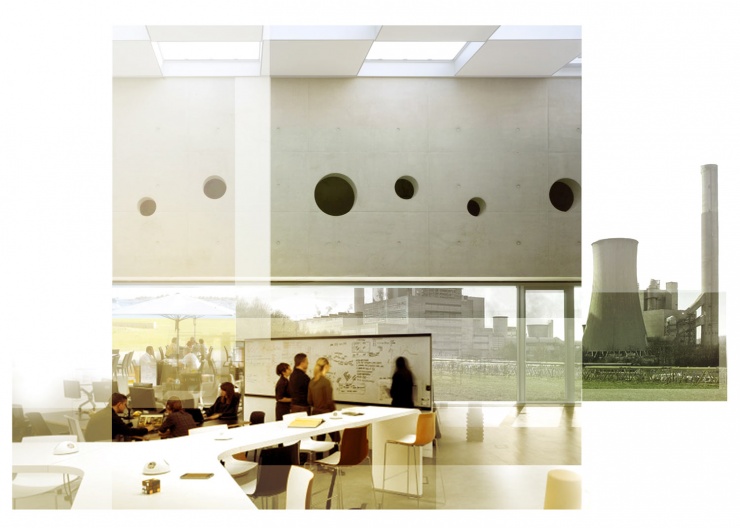-
Cooperative planning workshop | Visionary city | Village | Landscapes at the Garzweiler lake
-
Jüchen, Rheinisches Revier, Deutschland
-
Zweckverband LANDFOLGE Garzweiler
-
170 km²
-
in progress, 2020
-
2009-IVG
-
Raumbild, development strategies
-
Verena Brehm, Tim Kohne, Lydia Oehlwein, Jakob Bohlen, Lena Lauermann
-
Freiwurf Landschaftsarchitekturen, Thomas Gfeller
-
2. Prize
Innovation Valley Garzweiler
Due to the planned coal phase-out by 2038 and thus the elimination of a complete industry with many jobs, strong visions of the future already need to be developed today. How can we reintegrate the gigantic areas that will soon be fallow again in a sustainable manner and make them usable?
Located in the border triangle, our workshop was about developing a vision for the area in and around Garzweiler. The main goal here was to move away from the current linear to a circular economy. The starting point of the concept was the question of how we can draw a strong vision of the place that addresses its complex issues: What does innovation need? What will energy production look like in the future? How can we restore the immensely damaged ecosystem and reconnect the fragmented biotope network? And what do the municipalities and residents of the region need? How can all these aspects be thought of in a cycle and thus map a strong, sustainable system?
To give answers to all of these questions, the concept provides for the creation of an innovation network from three well-developed commercial locations in Jüchen, Jackerath, and Frimmersdorf, which tie in with existing plans. The conversion of the Frimmersdorf power plant, which is otherwise to be demolished (planned paralysis in 2021), creates a supra-regional innovation hub and acts as a gateway to the region. Its huge pre-built areas serve as a playground for start-ups as well as established companies. The power plant is a visual reminder of the cultural heritage and the important past of the region, but on the other hand, shows the big step forward towards a sustainable future. The pioneering spirit that has prevailed for decades is being rethought and translated into 2035.
Large contiguous recultivation areas for industrial agriculture feed electricity into the local grid through additional use for wind power and PV systems. We are creating ecological corridors (forestry recultivated, natural green structures), which in the future will span between the lakeshore and the forests of the Erft floodplain and, in addition to safeguarding the species network, also represent interesting areas for tourism. Thus the economic situation of the region is strengthened. They are lined with laboratory areas: small-scale fields and garden structures on which circular agriculture is researched, tested, and applied.
Garzweiler is an attractive area, but how can villages be developed, and what offers need to be created? Resource-saving, water management, or new forms of mobility are just a selection of important topics and factors that need to be considered. We propose different lighthouse regions in which to settle. In this way, for example, the new town of Niers am See is created. With the inevitable flooding of the Garzweiler II opencast mine and the resulting lake the size of the Tegernsee, there is an extraordinary opportunity for the realization of a model city with decentralized rainwater management and close networking in the adjacent natural biotopes. As soon as the opencast mining is completed, the respective villages can grow to the edge of the former mine and then have their own waterfront promenades in the final state.
The concept is rounded off by a cableway that links the various areas.
-
Cooperative planning workshop | Visionary city | Village | Landscapes at the Garzweiler lake
-
Jüchen, Rheinisches Revier, Deutschland
-
Zweckverband LANDFOLGE Garzweiler
-
170 km²
-
in progress, 2020
-
2009-IVG
-
Raumbild, development strategies
-
Verena Brehm, Tim Kohne, Lydia Oehlwein, Jakob Bohlen, Lena Lauermann
-
Freiwurf Landschaftsarchitekturen, Thomas Gfeller
-
2. Prize









